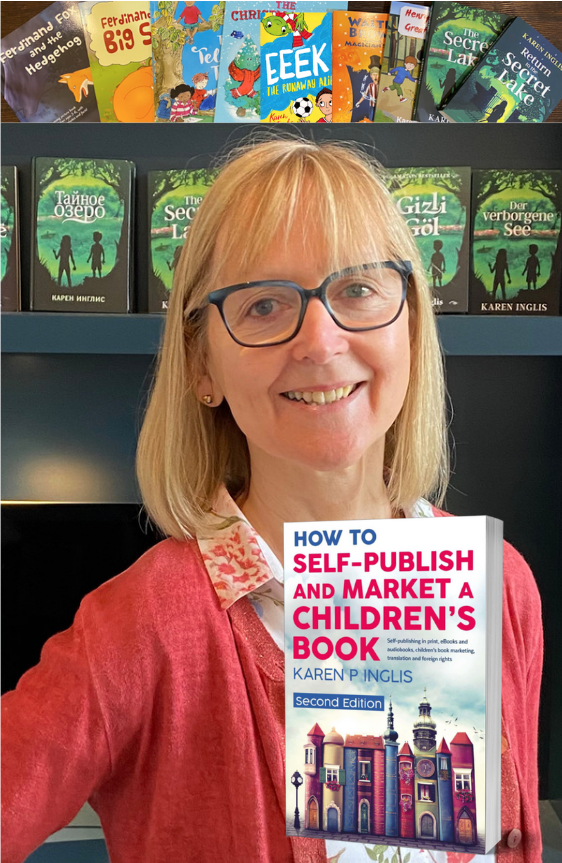After Early Rejection From Publishers, This Author Self-Published Her Book and Sold More Than 500,000 Copies. Here's How She Did It. Author Karen Inglis breaks down the strategies and tactics you need to generate awareness and sales for your self-published book.
By Dan Bova Edited by Jessica Thomas

Half-asleep on my commute home from work, the train jostled and dislodged in my brain an idea for a middle-grade reader book. I thought it would be fun to write (and fun for kids to read), so as soon as I got home, I ran straight to my computer and got right down to…doing nothing.
Then 15 years later, a global pandemic hit and I was out of shows to stream on Netflix. That idea was still bouncing around, so I finally started typing and doodling.
The result is a book I wrote and illustrated called Wendell the Werewolf, a funny (hopefully) adventure filled with gross-out jokes and other silly stuff.
Like many authors who find themselves typing the words "The End," I sat back satisfied, thrilled with myself. And then a creeping dread overtook me. Okay, now what? I wondered.
Publish it and become a bazillionaire, obviously, I told myself.
My first inclination was to try to go the traditional route: Pitch it to 100 agents, never hear back from most of them, pray to baby Jesus someone likes it, and if one of them does, then they pitch it to 100 publishers, more praying to baby Jesus, etc., etc.
As fun as that all sounds, after waiting 15 years to create this book, I couldn't wait another minute to get it out there. The increasingly loud groans I emit while bending down to tie my shoe remind me that I'm not getting any younger.
So I decided to self-publish Wendell. Happily, in the years between having this idea and actually getting it done, the stink of self-publishing has dissipated to a considerable degree. Once, a self-published book had that "straight-to-VHS movie" vibe, with the added visual of the author stapling together Xeroxed copies at Kinkos.
But these days, there are several platforms and companies that give you a good-looking product that looks and feels like a real book.
After exploring different options, I went with Amazon Kindle Direct. I did this for two main reasons: 1. It is easy enough for a dumbass like me to use and 2. They allow you to print copies on demand. This eliminates the financial risk that comes with having to pay for 1,000 copies — not to mention the heartbreak of boxes of unsold books reminding you of your failure every time you go in the garage to get the lawn mower out.
I'm breezing through these parts of the process (the writing and publishing parts), because I want to get to the question that many self-published and even traditionally published authors face once they have that book they've been thinking about for more than a decade in their hands: Now what? Part 2.
See, once you have your book published and listed on Amazon or your website, you might think that the sales will just start rolling in. (Spoiler alert: They don't.)
As much as you have killed yourself with long hours getting this thing written, edited, and laid out, your work is just beginning. I wanted some advice on what to do next with my book (and by extension, let you know what to do next with your book) so I reached out to an expert who really, really knows what she is talking about.
Related: 7 Writing Hacks Every Writer Must Know
Karen Inglis is an author who has written many books, including her self-published children's megahit, The Secret Lake, which has sold half a million copies worldwide to date. Inglis has written several award-winning books for kids of varying ages, which you can find on her website, and she kindly shared her hard-earned knowledge of the publishing game in her immensely informative How to Self-Publish and Market a Children's Book (Second Edition).

Photo credit: Karen Inglis
Speaking via Zoom from her office in Barnes, south-west London, Inglis shared her best advice for non-marketing-savvy folks like myself to get eyeballs (and hopefully "Buy Now" clicks) on their self-published stuff. Here are some helpful highlights from our conversation:
1. Before you publish your book, do this first
"Before you even think about self-publishing, make sure your story is right for your target age group. Start by reading books in your genre and for the age group you are targeting to get an understanding of themes, book length, chapter length, use of language, and so on. Once you have your final best draft, test it with audiences. This could be with local school children, friends and family, or a few teachers or children's librarians. This will help you spot and fix key issues early on — for example by letting you know when/if the children lose interest or if there are parts of the story they don't understand. Thereafter, hire a structural editor who knows specifically about children's books. Once you have your final draft, hire a professional cover designer who specializes in children's books."
2. Establish your brand online
"Besides your Amazon listing (see more below), create your own website. This will be your calling card. If you go to kareninglisauthor.com, you'll see I do not have a fancy, super modern-looking website. But you'll find that you can navigate it very easily, click around, and read about my different books and what age group they're for. It's just a WordPress website. I'm not saying that's what everyone should do by any stretch, but the templates are all easy to work with, plus I like the fact that they handle all the security for you."
3. Build your brand locally where your customers are
"Call local schools, libraries, books stores, and playgroups and ask if you can do a reading for the children. This is a great way to start building awareness through word of mouth. My first event was at a library. It was free — about seven parents and their children showed up. It was actually great because, at that level, it doesn't matter if you make a mistake. It allows you to comfortably test your presentation and see what is working with the kids and what isn't. And once you start to get in a good place, take some photos of the event and share your story with local news outlets or social media groups to build awareness."
4. Get to know keywords and categories on Amazon
"Amazon allows you to select what categories your book should be listed in, which aids with its search on the platform. Make sure you put relevant categories. You see some people try to game the system by putting their book in a very obscure, small category with the hopes that it might land them a 'best-seller' win with just a few sales. Doing this confuses Amazon's algorithm, which is trying to serve your book to people searching for ones like it. If you don't have the time or inclination to research keywords for your book, I would recommend using a service like Publisher Rocket, which can solve a lot of the pain of discovering what will work best."
5. Get your blurb right
"This is the description of your book on its Amazon page. Read blurbs for successful books in your genre, and try to make yours in keeping with what you know has worked for others. Now, this is the important part to consider: Your book is for kids, but the person buying it will be an adult. So your messaging isn't directed at the end consumer. This makes it a little more challenging than putting messages up on social media and getting those impulse buys on other kinds of products."
Related: The Entrepreneur's Guide to Writing a Book
6. Ask for reviews
"For every event or reading you do, ask people to review your book on Amazon. The number of reviews you have helps your book rank higher in search, and it also lets buyers see that this is a good bet to purchase. It can be quite tricky to get people to post reviews. Back in 2011, I created little flyers for my book that I left at the library with a picture of the book. The flier gave my contact information and asked if your child would like to be an early reader of the book for free. I provided them with a free copy of the book from my small author stock and a note that said I'd be grateful if you could help your child leave a review online. If you don't ask, people won't know what you want."
Related: 7 Tips to Help You Write the Book You Always Dreamed About
7. Kindle or print?
"Ninety-five percent of children's book sales are in print. You can and should have an ebook version, but know that the majority of sales will come from print. Amazon has a Kindle Unlimited subscription, and you can list your ebook on it. This can be a useful way to allow parents to look at the book first, essentially for free, and then order it if they think their child would like it."
8. Build a mailing list
"The last page of your book should give your website and a way for people to join your mailing list. Give them a reward for signing up — email them a PDF of a poster of the book cover for example."
9. Experiment with paid ads
"Amazon allows you to advertise on the platform with as little as a $5 budget, so I believe it is well worth experimenting with. People are on Amazon looking to make purchases. So converting a purchase doesn't involve them clicking off the platform they're seeing your ad on, unlike paid ads on social media. And Amazon offers many free resources and webinars to teach you how to get the most out of your ads. I personally found that advertising on Facebook was a waste of money. I would steer clear of that unless you've got money to burn."
10. Believe in yourself!
"If you've got the right story, you can have a morning like the one I've just had. I received an email from Slovenia looking to secure publishing rights. I've sold the foreign publishing rights to 10 different traditional publishing companies, and the book has been translated into 11 languages. I went from selling very few copies to having international editions, so if you've got the right story and believe in it, you can really get lucky."











